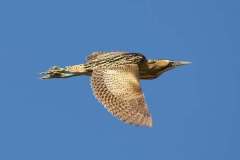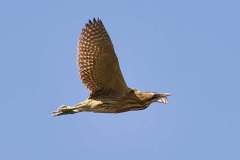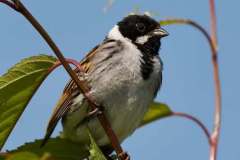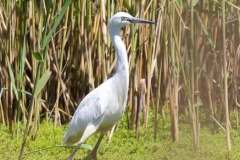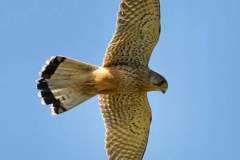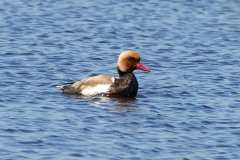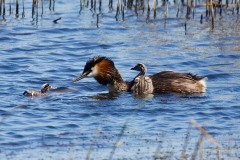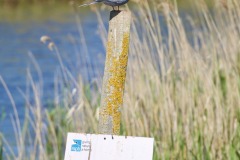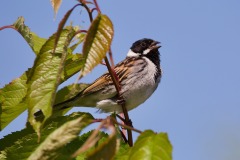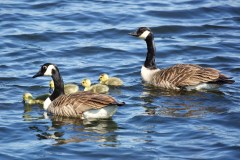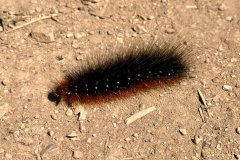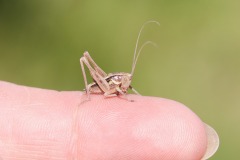Meeting Reports May 2025
Leader : Colin Howes
Other Attendees : Paul and Anne D; Ian F; Bob M; John N; John S; Tom (from Natural England).
Meet : 1.30 pm along Plumpton Park Road DN4 6SG (SE621005 )
During the afternoon we enjoyed guest celebrity appearances of John Craven, a notable member during the 1960s & 70s, brought by Bernard Russel, and Caroline Barrass, who energetically appeared on a trail-bike in preparation for a cycling expedition to the Isles of Mull and Islay.
At 1.30 pm on a warm, bright afternoon, during the prolonged spring drought, 11 members of the society met on Plumpton Park Road and proceeded to walk the labyrinth of meandering paths through the northern part of Hatchel Wood.
Although the populations of Bluebells and Wood Anemones, impressive earlier in the season, had largely withered into the background, our arrival off Plumpton Park Road was greeted by the piercing blue of the garden escape, Green Alkanet (Pentaglottis sempervirens). The woodland at large, seemed green and un affected by the drought, though significant evidence of lack of periodic rain showers was the glistening foliage of Sycamore, made wet and sticky with excess honeydew produced by unstoppable populations of Aphids. Under usual conditions, rains (particularly during bank holidays) normally reduce aphid populations and flush away excess honeydew.
The tree canopy, largely of Common Oak, was added to by Silver Birch, Cherry, Ash, and Limes (probably including native Large-leaved Lime and planted hybrid limes, some of which showed evidence of historic coppice management). Understory shrubs were primarily Hazel (some also coppiced) Holly and Elder with occasional bird-sown Rowan.
The dead-wood element, largely of felled old Oaks, with dead standing Birch and Cherry, provided habitat for wood-boring invertebrates and feeding/nesting sites for Woodpeckers and Nuthatches.
Woodland herbs included Climbing Corydalis, Dog Violet and Dog’s Mercury, and in clearings, Foxgloves and by paths Wood Avens and Three-nerved Sandwort. Areas of woodland floor were dominated either by dense thickets of Bramble or in dryer areas, stands of Bracken. Woodland grasses included Wood Millet (Millium effusum) Creeping soft-grass (Holcus mollis) and Wood Poa (Poa nemoralis) and ferns included Male Fern and Broad Buckler Fern. The opened woodland edge and mown grassy area around the entrance from Hatchell Drive included Hawthorn, Elm suckers, Raspberry and a ground flora including Forget-me-not, Herb Robert, Ground Ivy, Creeping Buttercup with tall ruderals of Broad Dock, Lesser Burdock, Cow Parsley and Hogweed, Creeping and Spear Thistles, Hairy Willowherb and Rosebay. The presence of Stinking Hellebore and a bed of Lily of the Valley (measuring 7m x 6m), usually plants of limestone woods, may have been introduced or be natural colonists of patches of glacial bolder clay. Birds included Blackbird, Blackcap, Chaffinch, Chiffchaff, Jackdaw, Jay, Robin and Wren.
In order to reach the larger section of Hatchel Wood isolated to the south of the M18 corridor we crossed an area of open mown grassland, a popular dog-walk and area of public open space. Curiously, this turned out to be of particular interest with botanists (essentialy John Scott and Tom from Natural England) finding rich pickings, including grasses, vetches and composites with the highlight being the rarely recorded Hairy Buttercup … to me a scruffy, flattened, downy version of Bulbous Buttercup with recurved sepals. Ian did well with plant galls with an interesting find on the blooming Broom bushes.
The Southern area of woodland had a similar flora to the northern sector but with a denser canopy, a greater tree and shrub diversity including Spindle, Guelder Rose and Aspen and a higher population of old Yew trees. A difference in the herb layer was the abundance of Enchanters Nightshade (Circaea lutetiana), beds of which lined most of the woodland paths. The bed of Lily of the Valley growing on a clay substrate was measured and found to cover an area 6m x 4m.
Bird food in the form of tiny green lepidoptera larvae presented themselves abseiling down from Oak canopies on long silken threads. A Spindle shrub hosted a voracious population of Spindle Ermine caterpillars (Yponomeuta cagnagella) feeding gregariously from within the protection of a silken web. These were thought initially to be larvae of a species of Sawfly.
Bird calls were of constant interest, though sadly the presence of Woodpeckers and Nuthatches was not confirmed. However, Tom’s younger ears picked out the high-frequency tinkling calls of Goldcrest in the dense Yew canopies. Paul and Anne identified an Opilionid (Harvestman) and a Click Beetle using an App on their iPhone (see following species list).
A linear clearing (north-west to south-east) through the woodland (evidently a way-leave for a gas main) features damp areas, presumably over clay, featuring patches of wet vegetation with Woody Nightshade, March Thistle, Yellow Iris, Tufted Hair-grass, Pragmites Reed, several Rush species (Hard, Soft, Jointed & Compact), Marsh Bedstraw and Common Figwort. This area is now getting overgrown with Goat Willow, Grey Willow and Downy Birch.
The Pond, which this year had managed to raise one brood of Mallards, is now heavily shaded with tree canopies and shows a very limited range of aquatic vegetation. For instance there was no sign of the Potamogetons, Water lilies and submerged oxygenating plants which used to occur. It was commented that this habitat feature needed opening up to the light on the south side, in the interest of its former biodiversity. Aquatic species previously known from the site included Bog Bean (Menyanthes trifoliate), Brooklime (Veronica beccabunga), Broadleaved pondweed (Potamogeton natans), White water-lily (Nymphaea alba) and Common Duckweed (Lemna minor).
Thanks to everyone who took part in this enjoyable and I think successful event. Please pass to me any additional records. In due course, invertebrates recorded by Bob Marsh and Plant Galls recorded by Ian Farmer will be added to the following species lists.
Preliminary table of records:
BOTANY
| Hatchell Wood (North) SE622005 | Ryton Way Community Grassland SE624006 | Hatchell Wood (South) SE625004 | |||
| Acer pseudoplatanus | Sycamore | Agrostis capillaris | Common Bent | Acer pseudoplatanus | Sycamore |
| Agrostis capillaris | Common Bent | Alliaria petiolate | Hedge Garlic | Agrostis capillaris | Common Bent |
| Arrhenatherum elatius | False Oat-grass | Anthoxanthem odoratum | Sweet Vernal Grass | Arrhenatherum elatius | False oat-grass |
| Artemisia vulgaris | Mugwort | Arrhenatherum elatius | False oat-Grass | Bellis perennis | Daisy |
| Bellis perennis | Daisy | Bellis perennis | Daisy | Betula pendula | Silver Birch |
| Betula pendula | Silver Birch | Centaurium erythraea | Common Centaury | Betula pubescens | Downy Birch |
| Betula pubescens | Downy Birch | Crepis capillaris | Smooth Hawk’s-beard | Brachypodium sylvaticum | Wood False Brome |
| Bromus hordeaceus | Soft-brome | Cytisus scoparius | Broom | Castanea sativa | Sweet Chestnut |
| Ceratocapnos claviculata | Climbing Corydalis | Dactylis glomerata | Cock’s-foot | Centaurium erythraea | Common centaury |
| Chamerion angustifolium | Rosebay Willowherb | Deschampsia cespitosa | Tufted hair-grass | Cerastium fontanum | Common Mouse-ear |
| Cirsium arvense | Creeping thistle | Hypochaeris radicata | Common Cat’s-ear | Ceratocapnos claviculata | Climbing Corydalis |
| Cirsium vulgare | Spear thistle | Leontodon autumnalis | Autumn Hawkbit | Chamerion angustifolium | Rosebay Willowherb |
| Corylus avellana | Hazel | Lolium perenne | Perennial Rye-grass | Cirsium palustre | Marsh Thistle |
| Crataegus monogyna | Hawthorn | Lotus corniculatus | Bird’s-foot Trefoil | Cirsium vulgare | Spear Thistle |
| Cytisus scoparius | Broom | Malva sylvestris | Common Mallow | Corylus avellana | Hazel |
| Dactylis glomerata | Cock’s-foot | Papavera dubium | Long-headed Poppy | Crataegus monogyna | Hawthorn |
| Deschampsia cespitosa | Tufted hair-grass | Plantago coronopus | Buck’s-horn plantain | Crepis capillaris | Smooth Hawk’s-beard |
| Digitalis purpurea | Foxglove | Plantago lanceolata | Lanceolate Plantain | Cytisus scoparius | Broom |
| Dryopteris dilatata | Broad Buckler-fern | Poa trivialis | Rough meadow-grass | Dactylis glomerata | Cock’s-foot |
| Dryopteris filix-mas | Male-fern | Ranunculus repens | creeping buttercup | Deschampsia cespitosa | Tufted hair-grass |
| Epilobium hirsutum | Great willowherb | Ranunculus sardous | Hairy Buttercup | Digitalis purpurea | Foxglove |
| Fraxinus excelsior | Ash | Rumex acetosa | Common Sorrel | Dryopteris dilatata | Broad Buckler-fern |
| Geranium molle | Dove’s-foot Crane’s-bill | Sisymbrium officinalis | Hedge Mustard | Dryopteris filix-mas | Male-fern |
| Glechoma hederacea | Ground-ivy | Trifolium medium | Zigzag Clover | Epilobium hirsutum | Great Willowherb |
| Heracleum sphondylium | Hogweed | Trifolium pratense | Red Clover | ||
| Holcus lanatus | Yorkshire-fog | Trifolium repens | White Clover | Festuca rubra | Red fescue |
| Holcus mollis | Creeping soft-grass | Tussilago farfara | Colt’s-foot | Fragaria vesca | Wild Strawberry |
| Hyacinthoides non-scripta | Bluebell | Ulex europaeus | Gorse | Galium aparine | Cleavers |
| Hypericum perforatum | Perforate st john’s-wort | Urtica dioica | Stinging Nettle | Galium palustre | Marsh-Bedstraw |
| Ilex aquifolium | Holly | Vicia sativa | Common Vetch | Glechoma hederacea | Ground-ivy |
| Juncus inflexus | Hard rush | Tragopogon pratensis | Goat’s Beard | Holcus lanatus | Yorkshire-fog |
| Lamium album | White dead-nettle | Holcus mollis | Creeping Soft-grass | ||
| Lapsana communis | Nipplewort | Hyacinthoides non-scripta | Bluebell | ||
| Lonicera periclymenum | Honeysuckle | Hypericum perforatum | Perforate St John’s-wort | ||
| Lotus corniculatus | Common bird’s-foot-trefoil | Ilex aquifolium | Holly | ||
| Malus sylvestris | Crab apple | Iris pseudacorus | Yellow iris | ||
| Milium effusum | Wood Millet Grass | Juncus articulatus | Jointed rush | ||
| Poa annua | Annual meadow-grass | Juncus conglomeratus | Compact rush | ||
| Poa trivialis | Rough meadow-grass | Juncus effusus | Soft-rush | ||
| Prunella vulgaris | Selfheal | Juncus inflexus | Hard Rush | ||
| Pteridium aquilinum | Bracken | ||||
| Quercus petraea | Sessile Oak | Lolium perenne | Perennial rye-grass | ||
| Quercus robur | Pedunculate Oak | Lonicera periclymenum | Honeysuckle | ||
| Quercus x rosacea | Hybrid Oak | Lotus pedunculatus | Greater Bird’s-foot-trefoil | ||
| Ranunculus repens | Creeping Buttercup | Circaea lutetiana | Enchanters Nightshade | ||
| Rosa canina | Dog-rose | ||||
| Rubus fruticosus agg. | Bramble | Phragmites australis | Common Reed | ||
| Rumex obtusifolius | Broad-leaved Dock | Plantago coronopus | Buck’s-horn Plantain | ||
| Rumex crispus | Curl Dock | Poa nemoralis | Wood meadow-grass | ||
| Salix cinerea | Grey willow | Poa trivialis | Rough meadow-grass | ||
| Sambucus nigra | Elder | Populus tremula | Aspen | ||
| Senecio jacobaea | Common ragwort | Prunella vulgaris | Self heal | ||
| Silene dioica | Red campion | Prunus spinosa | Blackthorn | ||
| Sorbus aucuparia | Rowan | Pteridium aquilinum | Bracken | ||
| Stellaria media | Common Chickweed | Quercus petraea | Sessile oak | ||
| Tilia x vulgaris (Tilia x europaea) | Limes | Quercus robur | Pedunculate oak | ||
| Trifolium repens | White clover | Quercus x rosacea | Hybrid oak | ||
| Tussilago farfara | Colt’s-foot | Ranunculus repens | Creeping buttercup | ||
| Ulmus glabra | Wych Elm | Rumex obtusifolius | Broad-leaved dock | ||
| Viburnum opulus | Guelder-rose | Rosa canina | Dog-rose | ||
| Viola riviniana | Common Dog-violet | Rubus fruticosus agg. | Bramble | ||
| Stellaria holostea | Greater Stitchwort | Rumex sanguineus | Wood dock | ||
| Salix caprea | Goat willow | ||||
| Salix cinerea | Grey willow | ||||
| Sambucus nigra | Elder | ||||
| Scrophularia nodosa | Common Figwort | ||||
| Senecio jacobaea | Common Ragwort | ||||
| Silene dioica | Red campion | ||||
| Solanum dulcamara | Woody Nightshade | ||||
| Sorbus aucuparia | Rowan | ||||
| Taxus baccata | Yew | ||||
| Teucrium scorodonia | Wood sage | ||||
| Ulex europaeus | Gorse | ||||
| Ulmus glabra | Wych elm | ||||
| Urtica dioica | Stinging Nettle | ||||
| Veronica beccabunga | Brooklime | ||||
| Viola riviniana | Common Dog-violet | ||||
| Stellaria holostea | Greater Stitchwort | ||||
Zoology
| Hatchell Wood (North) SE622005 | Ryton Way Community Grassland SE624006 | Hatchell Wood (South) SE625004 | |||
| Oryctolagus cuniculus | Rabbit | Oryctolagus cuniculus | Rabbit | Oryctolagus cuniculus | Rabbit |
| Sciurus carolinensis | Grey Squirrel | Talpa europaea | Mole | Sciurus carolinensis | Grey Squirrel |
| Talpa europaea | Mole | Talpa europaea | Mole | ||
| Pararge aegeria | Speckled Wood | Pararge aegeria | Speckled Wood | ||
| Pieris rapae | Small White | Pieris rapae | Small White | ||
| Columba palumbus | Wood Pigeon | Vanessa atalanta | Red Admiral | ||
| Corvus monedula | Jackdaw | Yponomeuta cagnagella | Spindle Ermine Moth | ||
| Erithacus rubecula | Robin | Athous hemorrhoidalis | A Click Beetle | ||
| Fringilla coelebs | Chaffinch | Rilaena triangularis | A Harvest Spider | ||
| Garrulus glandulaius | Jay | Anas platyrhynchos | Mallard | ||
| Phylloscopus collybita | Chiffchaff | Buteo buteo | Buzzard (overhead) | ||
| Sylvia atricapilla | Blackcap | Columba palumbus | Wood Pigeon | ||
| Troglodytes troglodytes | Wren | Corvus monedula | Jackdaw | ||
| Turdus merula | Blackbird | Erithacus rubecula | Robin | ||
| Fringilla coelebs | Chaffinch | ||||
| Garrulus glandulaius | Jay | ||||
| Phylloscopus collybita | Chiffchaff | ||||
| Regulus regulus | Goldcrest | ||||
| Sylvia atricapilla | Blackcap | ||||
| Troglodytes troglodytes | Wren | ||||
| Turdus merula | Blackbird | ||||
CAH.
Leaders : Paul & Joyce Simmons.
Other Attendees :
Meet : 10.30 am in Reserve car park, off Leeds Road LS6 8AL (SE399287)
Seven members met in the RSPB car park on a glorious spring day at 10.30am, being on time despite roadworks on the A1.
St. Aidans at this time of the year is a noisy place. That is mainly the huge number of nesting Black-headed Gulls. Lapwings were displaying as well over the heathy ground.
Black-necked Grebes were not showing themselves, despite several pair known to be in the areas which we visited. Presumably the females were sitting on eggs with the males in attendance. The most unexpected sighting was of a Red-headed Pochard, not normally a nesting bird here. The most exciting sightings were of Bitterns. There were two flying together, but the best was one standing in the reeds and allowing excellent views. We left before he did!
Birds seen: Red Kite, Buzzard, Mute Swan, Canada Goose, Graylag Goose, Mallard, Gadwall, Shoveler, Pochard, Red-crested Pochard, Tufted Duck, Coot (with any young), Moorhen, Black-headed Gull, Lesser Black-backed Gull, Common Tern, Little Grebe, Great-crested Grebe, Reed Bunting, Carrion Crow, Magpie, Cormorant, Grey Heron, Lapwing, and Redshank.
Jim Burnett
Leaders : Tom Higginbottom and Catherine Palmer.
Other Attendees :
Meet : 10:30 am in the car park DN5 7XJ (SE507070 )
To view Green-winged Orchids in the grounds of Brodsworth Hall
Leader : Louise Hill
Other Attendees :
Meet : 4.30 a.m. at
A gentle stroll of 2km around Woodman’s Trail, Sandal Beat Wood.
